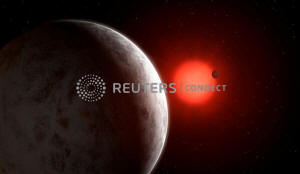Planets around nearby star are intriguing candidates for
extraterrestrial life
 Send a link to a friend
Send a link to a friend
 [June 27, 2020]
By Will Dunham [June 27, 2020]
By Will Dunham
WASHINGTON (Reuters) - Up to three planets
- potentially rocky like Earth - have been spotted around a star located
relatively near our solar system - a planetary system offering
astronomers intriguing possibilities in the search for signs of
extraterrestrial life.
The planets orbit Gliese 887, a so-called red dwarf star half the sun's
mass located 11 light years from Earth - right in our backyard in cosmic
terms, researchers said on Friday. A light year is the distance light
travels in a year, 5.9 trillion miles (9.5 trillion km).
Only 12 other stars are closer to our solar system.
Two planets have been definitively identified, one orbiting Gliese 887
every nine days and the other every 21 days. One of these two is
situated just inside what is called the habitable zone, or Goldilocks
zone, around the star - not too hot and not too cold, perhaps able to
maintain liquid water on the surface and harbor life.
A third potential planet orbiting every 50 days is located in the
habitable zone, but still needs further confirmation.
"They are 'super-Earth' planets, which means that they are a few times
the mass of the Earth and are expected to have a solid core like the
Earth, as opposed to the big gas giants such as Jupiter and Saturn,"
said astronomer Sandra Jeffers of the University of Göttingen in
Germany, lead author of the research published this week in the journal
Science.

[to top of second column]
|

The multiplanetary system of newly discovered super-Earths orbiting
nearby red dwarf star Gliese 887 is seen in this artist's
impression. Mark Garlick/Handout via REUTERS.

"The newly detected planets are the best possibilities of all the
known planets in close proximity to the sun to see if they have
atmospheres and to study these atmospheres in detail," Jeffers
added, to learn whether their conditions are "amenable for life."

This planetary system will be a key target for study using NASA's
next-generation James Webb Space Telescope, due for a 2021 launch,
Jeffers said.
Red dwarf stars are relatively small and cool. Gliese 887 is
exceptionally inactive in terms of energetic outbursts and dark
starspots, meaning it could be hospitable to life on the planets in
its orbit.
(Reporting by Will Dunham; Editing by Sandra Maler)
[© 2020 Thomson Reuters. All rights
reserved.] Copyright 2020 Reuters. All rights reserved. This material may not be published,
broadcast, rewritten or redistributed.
Thompson Reuters is solely responsible for this content. |